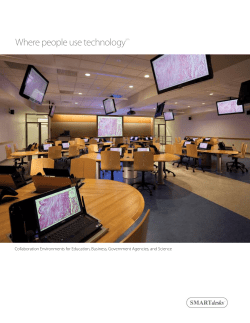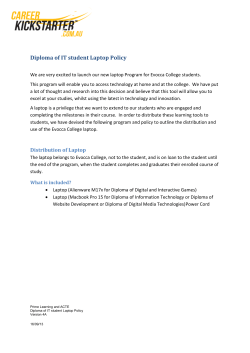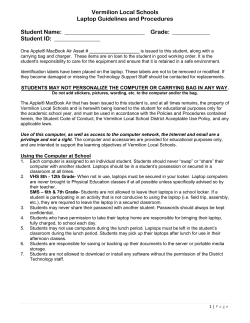
Document 65954
One Laptop per Child Economics and Management in Developing Countries Eric Dulaurans, Kun Hsu, Veena Lertpachin, Andras Torok, Ailin Yang Introduction While most of us take for granted the access we have to technology and education, the vast majority of children around the world continue to be without even the most basic of these. According to a running tally at Advanced Micro Devices, only about 1 billion, or 16 percent of the 6.5 billion people living today, use the Internet. Needless to say, a large percentage of those one billion internet users are clustered in Western developed countries. It is estimated that for most third world countries the PC penetration rate remains in the low single digits, with mobile phone typically outnumbering PC’s anywhere from 6 to 1 to as much as 20 to 1. This contrasts the over 90% PC penetration rate in the United States today. In recent years, as corporate social responsibility has become the new “IT” child in the business world, the concept of the $100 laptop has received more widespread media coverage. Non-profit organizations such as the One Laptop Per Child (OLPC) have caught international attention, with industry giants such as Intel and Microsoft getting on board for this cause as well. It is easy to list the benefits of bringing inexpensive computers to the billions of people who live in rural villages and urban centers in the developing world. However, building a low-cost, resilient machine that suits the needs of a vast range of peoples has proven to be more difficult than expected. In addition, the question remains whether providing one laptop per child is truly the best means of addressing the needs of developing countries or whether resources are better directed elsewhere. The following paper focuses on the One Laptop per Child organization and will aim to address some of the aforementioned issues in the following way: 1. Overview of One Laptop per Child 2. OLPC on the Ground a. Brazil b. Thailand 3. Impact of One Laptop per Child 4. Challenges of Investing in Laptops 5. Implementation 6. Conclusion 2 One Laptop Per Child: Overview The Origins of the One Laptop per Child (OLPC) project date back to the late 1960’s. And in January 2005 the OLPC initiative was officially announced at World Economic Forum. Nicholas Negroponte, founder and chairman of OLPC, was also co-founder and director of the MIT Media Laboratory, and the Jerome B. Wiesner Professor of Media Technology. OLPC is funded by a number of sponsor organizations, including AMD, Brightstar Corporation, eBay, Google, Marvell, News Corporation, SES Global, Nortel Networks, and Red Hat – each has donated two million dollars. The mission of the OLPC is to ensure that every school-aged child in less-developed countries is able to engage effectively with their own personal laptop, networked to the world, so that they, their families and their communities can openly learn and learn about learning. To that end, the OLPC developed the “XO” laptop. These laptops will be sold to governments and issued to children by schools on a “one laptop per child” basis. Since its launch, OLPC has made significant headway in refining the product as well as signing on several countries, including Libya and Rwanda. The Laptop: XO The XO is a unique machine designed collaboratively by experts from both academia and industry. The goal was to create a powerful learning tool for the world's poorest children, living in its most remote environments. The XO was designed to be low-cost, small, durable, and efficient and addresses issues such as availability of electricity, connectivity to other machines, etc. It is also fully compliant with the European Union's RoHS Directive and contains no hazardous materials. Its NiMH batteries contain no toxic heavy metals, plus it features enhanced battery management for an extended recharge-cycle lifetime and tolerates alternate powercharging sources. The result is a device about the size of a textbook and lighter than a lunchbox. The multifunctional design and “transformer" hinge enable the laptop to be easily configured for standard laptop use, e-book reading, and gaming. It will be shipped with a slimmed-down version of Fedora Linux and a GUI called Sugar that is intended to help young children collaborate. The package will also include a video camera, microphone, long-range Wi-Fi, and a hybrid stylus/touch pad. For use at home and where power is not available, the XO can be hand powered allowing operation far from commercial sources of power. The estimated product life is 5 years. 3 Why Children and Why a Laptop? It is often said that children are our future. Unfortunately, of the nearly two–billion children in the developing world most are inadequately educated, or receive no education at all. In fact, one in three does not complete the fifth grade. For third world countries to advance, they must invest in the education of their children, their most valuable resource. Without education, children will grow up to be in much the same situation as their parents – impoverished and isolated. The founders of OLPC argue that given many children, especially those in rural parts of developing countries, have so little access to school, building schools and training teachers is only one way and perhaps the slowest way to alleviate the situation. While these initiatives must continue, leveraging the children themselves by directly engaging them in their own learning can be done in parallel. With the XO, children will have access to opportunities never before available. Tools such as a Web browser, rich media player, and e-book reader bring into reach domains of knowledge that are otherwise difficult-or impossible-for these children to reach. The XO acts as a gateway for children, their families and the community to the rest of the world. It also enables them to share their best practices with others. Each school represents a learning hub; a node in a globally shared resource for learning. The Program To enhance the sustainability and effectiveness of the XO laptops as learning tools children, their families and communities in these lesser developed countries, the OLPC is focusing on stimulating grassroots innovations. In the early stages, the organization is concentrating on those governments that have made commitments for the funding and program support necessary to ensure each child owns and can effectively use a laptop. Grants and loans are provided for developing and using open source education tools and grassroots level learning. Proposals can include topics such as: a) Online, open source, wiki-textbooks, math and science projects, dictionaries, geographies, histories, social studies, health and nutrition courses, translations into indigenous languages. These materials can be customized for a particular region or group of children or for more general use throughout the XO world. b) Software not otherwise available on XO that enhance the general usefulness of XO's in every location. Examples include educational games, collaborative and archiving tools, artistic, video and graphic tools. c) Peripherals that increase effectiveness of XO. This may include a variety of manual battery chargers and low-cost USB peripherals that extend the ways the XO can be used to benefit children, their families and their communities. d) Organizational capacity building innovations that will enhance children's learning by improving their broader learning environment and/or by enabling them to become acquainted with and interact with children from different countries and cultures. All materials and peripherals developed with the support of the OLPC Foundation must follow open source formats and standards and be available without fee for use by any child with an XO laptop. 4 OLPC on the Ground So far, OLPC`s plan was to concentrate effort on a few large developing countries around the world (China, India, Thailand, Egypt and Nigeria, Argentina and Brazil in Latin America). This strategy seems to have been dictated by several reasons: a) The need to operate at a large scale, typical of cost-minimization goals of the program, required countries able to acquire large numbers of laptops; b) Constraints in the human capabilities of OLPC pointed to the need to focus on a number of engagements with a limited selection of potential clients, in contrast to the time and effort needed to coordinate a more demanding series of numerous small and medium country programs. c) The program’s emphasis on full country commitment with the program in all its critical components, as opposed to the purchase of a small group of laptops that would only marginally add to education plans, minimizing the intended impacts on learning. Both Brazil (at the Presidential level) and Argentina (at the Minister of Education level), have stated publicly that they are willing to participate and acquire one million laptops each. Also, Thailand and Nigeria also placed orders (1 million units each), but their political support for the program is much less stable. Regardless of not being included in the initial OLPC plan, other countries in the region have been exposed to information about the program. An informal survey of their reactions indicate that most governments have developed a measure of interest in the possibilities of the 100 dollar computer, yet they have been discouraged by one or a combination of the following factors: • The rules and conditions applying to the use of the laptops are not well known. This includes concerns about proprietary designs, ability of beneficiary countries to customize the machine or the software to fit their needs, availability and user-agreements regarding software and related issues. • The explicit focus on large countries and large volumes as a precondition for participation has led some governments in small and medium-sized countries to conclude that any benefit they could derive from the program was likely to arrive too late in time to make sense for their current plans (they would be sent to “the end of the queue” to the point of not been in position to receive the laptop before a waiting period of three to four years). • Preliminary financial estimates indicated that total costs of operation for a program involving the machine would reach well above the 100 dollars per laptop. Sources of these extra costs include mostly two large categories: complementary educational expenses to be required so that the schools can get the most out of the program–teacher training, connectivity -, and fiscal and logistical expenses (transportation, storage, distribution, service, tax exemptions and so on and so forth). 5 Brazil Brazil was among the first developing countries to have OLPC notebooks targeted at a practical education application. Administration advisers responsible for selecting the platform used in the country's national education program received the equipment around November 2006. The Laboratory for Integrated Systems at the University of São Paulo also tested 15 of the motherboards that are to be used in the 2B1 model notebook from the OLPC in 2006. The state deployed the notebooks in schools in February. To meet this goal, the OLPC delivered a second shipment of 1,000 2B1 notebooks in January. The first 50 devices went researchers in various Brazilian institutions, who familiarized themselves with the systems in order to develop regional applications. Brazil's introduction of the 2B1 models is related to the recent announcement made by Quanta Computer, the Taiwanese company manufacturing the device's hardware. The company has moved up the production from the second quarter of 2007. The current price estimate for the 2B1 is $140. Negroponte has said that the production of $100 laptops would start when there was a minimum of 5 million devices on order. Negroponte foresees $100 devices reaching a wide scale in the worldwide market in 2008. Competition from INTEL in Brazil In Brazil, the wide scale deployment of the OLPC project is not entirely sure yet. Intel is also negotiating with the Brazilian government about its Classmate PC that competes with the One Laptop Per Child (OLPC) project's XO laptop, which is also undergoing evaluation. The government of Brazil plans to select one of the machines for broad deployment in schools across the country. Although Intel's Classmate PC and OLPC's XO laptop both aim to bring low-cost mobile computing to students, the two systems reflect distinctly different approaches to education computing. Thailand Thailand conducted initial trials with the laptops at the end of last year, however, the changes in the government slowed down the process significantly. Although Thailand was initially a supporter of the OLPC project, the country withdrew its support after a coup d'état led to significant shifts in national leadership. Thailand's new military government, which first rejected the project, has reconsidered and decided to remain involved after meeting with OLPC representatives in Thailand. Thailand also received a second testing batch of 2,500 laptops in February 2007 which were distributed among the testing schools. 6 Impact of One Laptop Per Child Nicholas Negroponte has classified the One Laptop per Child project as “an education project” and not a laptop project and thus not a technology project. Through years of economic research it has been consistently shown that there is a strong correlation between education and economic growth. Therefore an ambitious project that proposes to vastly increase the education levels of children in developing countries should result in sustained economic growth for these countries. This is because education would not only benefit these children in greater earning potential throughout their lives but also provide positive externalities to their communities. The relationship is well encapsulated in the following flow-chart: “Returns to Education in Low Income Countries: Evidence for Africa (1).” The target age range for XO laptops remain children in grade school. From a development perspective this is the correct age range to create the largest impact. According to research conducted by George Psacharopoulos “Primary education makes the most valuable contribution to an individual’s expected income in developing countries (2).” The economic payoff to such a project as the OLPC would be hard to predict because an ambitious project such as this which incorporates this new type of new technologies has not been implemented before, however there are strong reasons to believe that the project could very well provide enormous benefits. 7 Economic Promoting Features of the XO and OLPC Technology -- Reframing the project in other terms, the OLPC mission is just as much a technological advancement leading to potential growth as an educational advancement. The OLPC and XO are only possible through the advance of technology and expertise in manufacturing that allow for such low prices. In addition, the project could assist development in countries in similar ways to that of mobile telephony. New technological features such as mesh-networking allows for a means of communication and information exchange with a broader reach. Each computer is able to utilize the internet connection of another computer within range, and therefore only one internet connection is required for a group of laptops. Creating much more accessibility than possible before and as a versatile laptop there is a far greater range of possible educational and economic uses. Other technological features such as low power consumption and a kinetic crank to provide energy when no electricity is available allows for use of the XO in remote areas. Knowledge Transfer and Communication -- It is arguable whether a laptop will teach children the necessary skills to be more productive within their dismal economic realities. Some might argue that it may be better to allocate resources to teach children more technical or practical skills such as agriculture than provide them with a computer that may not produce material returns (This argument will be explored further in the Challenges section). However, there is evidence why a laptop could provide enormous benefits to economies. With the development of content by public sources (e.g. Governments and NGOs) the knowledge on how to accomplish these tasks can be communicated and in addition can be shared with other laptop users. In very similar ways to the usage of terminals in India called e-Choupal. Self-Learning -- Education systems in areas where the OLPC is targeting are generally quite poor. Often no class materials are available and teachers are poorly educated themselves. The laptop has the potential to break the self-propagating cycle of poor education and lack of funds resulting in each new generation being poorly educated. The laptop will allow children to have information transferred from outside of their educational ecosystem. In addition, they could learn in areas where the school system has broken down, does not exist or instability renders education in classrooms too dangerous. Enabler of Economic Activity – The laptops, though an educational tool, have the opportunity to be an enabler of economic activity as well. As has been shown with mobile telephony in other developing countries, there are many creative ideas that can result in economic benefits if the right platform is available. The laptop could potentially become an engine for entrepreneurialism. The laptops in many instances could be used by the entire family in countless ways to start businesses in addition to being a knowledge source for the children. 8 Factors Required for Greatest Utility Institutions -- In the view of most development economists, education would not be the primary factor that drives growth, instead that honor falls to the quality of Institutions. The quality of the institutions is essential for any program like this to succeed. Education System Support -- The governments of countries rolling out XO laptops will use the laptops as a tool used in tandem with some classroom education as well. Selecting Amongst Alternatives with Scarce Resources The idea that education provides these benefits is surely not the main point of contention. It is not disputed that the OLPC project will benefit a great number of children. It is a question of whether this is the best use of a government’s limited funds for education and international aid. “Given the resources that poor countries can reasonably allocate to education— sometimes less than $20 per year per pupil, compared to the approximately $7500 per pupil spent annually in the U.S.—even a doubled or redoubled national commitment to traditional education, augmented by external and private funding, would not get the job done. Moreover, experience strongly suggests that an incremental increase of “more of the same”—building schools, hiring teachers, buying books and equipment—is a laudable but insufficient response to the problem of bringing true learning possibilities to the vast numbers of children in the developing world.” Nicholas Negroponte "We cannot visualize a situation for decades when we can go beyond the pilot stage. We need classrooms and teachers more urgently than fancy tools." Indian Education Minister 9 Challenges of Investing in OLPC While there are many potential benefits to be derived from the $100 laptop project, critics contend that it may not be as simple as it seems. As the consumers are children in developing countries, there are many social and political factors which can hinder the success of this project. The initial rollout of this project will provide children with cheap laptops in line with the purpose of broadening their educational and technological horizons. However, not much thought has been placed into the long-term horizon and issues such as technological support and educational sustainability have not been thoroughly considered. Given the budget constraint in the production of these laptops, manufacturers have had to exclude some technological features which have prompted critics to question the real long-term benefits children can derive from these laptops. With a 500MHz processor and 500MB of local storage, the laptop is by no means a performance machine. Therefore, this limits the scope of functions which can be performed on this laptop and the potential to upgrade the software components of the laptop. Other technological factors which may pose a problem are virus management, software availability once funding has been exhausted, and the practicality of manually generating power to operate the machine in lieu of traditional electricity. Although children in developing countries do not require sophisticated levels of computer performance, the fact that the laptop cannot be easily upgraded means that it will very likely become obsolete within a five year timeframe. Once it is obsolete, there is the additional problem associated with components disposal. The manufacturers have thus far attempted to develop the laptop using environmental friendly materials. However, this still does not eliminate the ultimate accumulation of waste once the laptop becomes obsolete. Critics of the laptop program suggest that the costs of environmental waste do not justify the seemingly unsustainable technological benefits children will receive from using the laptops. There are also social factors which pose as challenges to the viability of the laptop program. The target consumer segment in this case will be children in developing countries where digital awareness is not a top priority. It is more likely that these children and their families face adversities that far supersede technological illiteracy. Many of these families suffer from underdeveloped living conditions and financial stability remains elusive. Unlike parents in developed countries who have the time and education to provide guidance to their children in the usage of technology, the parents in this case are more concerned with provision of basic needs for their family. Without proper coaching and guidance, neither the parents nor the teachers will be able to effectively provide support in the usage of technology. Higher education is a luxury for children and the quality of primary and tertiary education is already inadequate. Critics argue that rather than giving these children laptops which they will not gain maximum benefits from given their socio-economic environment, it would be a more fruitful to focus on first improving the quality of the education system. Only after the education system itself is capable of providing these children with a sound education, then the addition of digital education would be an appropriate solution to help them bridge their digital divide from 10 their developed country peers. As of now, the divide between a high quality education and that which is low quality is too large for a laptop to compensate. Another important consideration which shouldn’t be overlooked is the monitoring issue. Given the resource scarce environment in most developing countries, those in or with access to positions of high power often abuse their appropriation rights. Since the laptop program will be primarily funded through the form of government projects, it remains a risk that those in charge of distributing the laptops could make financial gains through arbitrage, that is by selling it above average income purchasers who may want to have the laptop as a “trendy item”. It would be a pity for these laptops to fall into the hands of children or even adults who don’t need them. Overall, it remains to be seen whether the investment of funds into the laptop project will indeed yield favorable results. Of course, this leads to another problem: How can the benefits gained from the laptop project are appropriately measured? There is no benchmark against which this landmark project can be compared against. Moreover, it is difficult to measure how much a child would have gained had the funds been allocated to an improvement in the overall education system. Even within this construct, varying elements ranging from investment in training teachers to investment in libraries could yield different levels of impact. In the world of development, the term “empowerment” itself is an overused term that has yet to be measured with quantifiable results. In this case, there is the question of whether the laptops will even offer empowerment to its beneficiaries. 11 Implementation Distribution The laptops will be sold to governments and issued to children by schools on a basis of one laptop per child. Children and teachers in developing countries whose governmental leaders have partnered with OLPC will receive an XO box in the initial stage, on only those. The OLPC is in no way involved in the actual physical distribution or the processes governing it. Those are national prerogatives of the countries buying the laptops. An additional, modest allocation of machines will be used to seed developer communities in a number of other countries. Given the characteristics of the project, the OLPC is initially available only to national government agencies —i.e. Ministry of Education— in order to simply achieve the initial economy of scale and a sufficiently large impact to make it sustainable. There are plans to expand the market and include other smaller and/or distributed organizations that will cater to people, places and situations where government agencies are unavailable - in the future and most likely collaborating through and with other parties. But trying to satisfy isolated retail requests will divert precious energy that would otherwise be more effective at larger scales and for the initial targets. A commercial version of the machine will be explored in parallel but will not be realized in this initial phase of the project. Manufacturing The preliminary schedule is to have units ready for shipment by the first quarter of 2007. Manufacturing will begin only when 5 to 10 million machines would be ordered and paid for in advance. Quanta Computer Inc. of Taiwan has been chosen as the original design manufacturer (ODM) for the $100 laptop project. Quanta Computer Inc. was founded in 1988 in Taiwan. With over US $10 billion in sales, Quanta is currently the world's largest manufacturer of laptop PCs. The company also manufactures mobile phones, LCD TVs, and servers and storage products. In addition, Quanta recently opened a new US $200 million R&D center, Quanta R&D Complex (QRDC), in Taiwan. The facility, which opened in Q3 of 2005, has 2.2 million square feet of floor space, and a capacity to house up to 7,000 engineers. Training Since each country can have more its own software set, the training really does have to be country specific and will be held responsible by the country in which the XO box will be implemented. 12 Conclusion The first generation of OLPC laptops, between five and 20 million machines, is being built by Quanta Computer, Inc., in Taiwan, by far the world’s largest manufacturer of laptop computers. The machines are scheduled to ship in the first quarter of 2007. A Generation Two machine, which will feature advanced electronic ink technology in its display, is planned for manufacture in 2008, with a projected total of 100-200 million units. OLPC`s plan was to concentrate effort on a handful large developing countries around the world. This strategy seems to have been imposed by several reasons: • Operate at a large scale, to minimize the cost of the program, requiring countries been able to acquire large numbers of laptops; • Focus on a number of engagements with a limited selection of potential clients to maximize implementation forces • The need to have the full country commitment with the program in all its critical components. By putting the major responsibilities on the governments of developing countries, and by providing anew low cost tool for children to learn only two issues remain unanswered: - What is the total cost of the program (which includes a substantial amount of resources beyond the cost of the laptop itself)? - Are countries wrong in investing in technology for education? 13 References Cited (1) “Returns to Education in Low Income Countries: Evidence for Africa.” by Michaelowa, Katharina. (2000). http://www.hwwa.de/Projects/Res_Programmes/RP/Development_Processes/VfS_EL_2000_Rev2.pdf (2) (3) (4) (5) (6) (7) (8) (9) (10) (11) (12) “Returns to Education: A Further International Update and Implications.” Psacharopoulos, George. (1985) - The Journal of Human Resources, Vol. 20, No. 4. pp. 583-604 “One Laptop per Child (OLPC), a $100 laptop for the world's children's education” http://www.laptop.org “The 2B1 Children's Laptop Will be Green” http://www.laptopical.com/2b1-laptop.html “The making of the $100 Laptop” http://www.dcontinuum.com/content/show.php?id=4 “The OLPC Wikipedia all pages index” http://wiki.laptop.org/index.php?title=Special%3AAllpages&from=&namespace=0 “The Five OLPC Principles” http://wiki.laptop.org/go/Core_principles “World’s poorest don’t want ‘ $100 laptop’ “ by Peter Apps, December 14th, 2005, Reuters. “UN debut for $100 laptop for poor” by Jo Twist, November 11, 2005, BBC News. “Plugging Africa’s kids in to $100 laptop” by Jessica Dolcourt, April 11, 2007, CNET.com. “Problems with the $100 laptop” by Lee Felsenstein, November 10, 2005, Fonly Institute. “PCs for the poor: Which design will win?” by Michael Kanellos, February 15, 2006, ZDNet News. 14 Appendix • Creates own mesh network out of the box. Mesh network antennas, which far outperform the typical laptop, double as external covers for the USB ports • Each machine is a full-time wireless router. Allows machines to be connected to one another and the Internet • Screen: 7.5 inch, 1200×900 pixel, TFT screen and self-refreshing display with higher resolution (200 DPI) than 95% of the laptops on the market today • Two display modes: transmissive, full-color mode, and reflective, high-resolution mode that is sunlight readable • Selective suspension of CPU operations makes significant power savings possible – nominally consumes less than two watts (1/10 of what a standard laptop consumes) • Integrated handle is kid-sized, as is the sealed, rubber-membrane keyboard • Novel, dual-mode, extra-wide touchpad supports pointing, as well as drawing and writing. • XO has no hard drive and only two internal cables – laptop components most likely to fail are the hard drive and internal connectors • Plastic walls are 2mm thick (standard is1.3mm) to provide added robustness • Display cushioned by internal “bumpers” 15 Schoolchildren with laptop in rural Thailand 16
© Copyright 2025





















